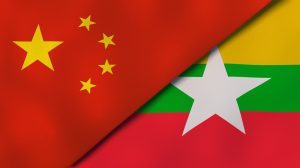On December 24, Myanmar officially took delivery of a submarine from China after a planned commissioning ceremony for the boat. While the development was far from unexpected, it nonetheless spotlighted the Myanmar military’s continued emphasis on building up its capabilities in spite of the shorter-term challenges it faces in consolidating control of the post-coup environment in the country, and Beijing’s growing role in that process.
While accounts of the capabilities of the Myanmar military usually highlight its status as of the biggest armed forces in Southeast Asia quantitatively speaking, defense officials have also long made the case for additional capabilities to protect the country’s over 2,000-kilometer-long coastline and surrounding territorial waters. In recent years, China has helped the Tatmadaw boost its maritime capabilities as one of its key arms suppliers, with Beijing transferring naval equipment over the past few years and this showing few signs of ebbing despite the February 2021 coup.
Within the framework of this objective, Myanmar has been looking to develop a submarine capability, as part of building up what the Tatmadaw has termed “three dimensional” capabilities in the aerial, surface, and subsurface domains. While this submarine quest was limited to some modest overseas training in the past, a key inflection point came in March 2020, when it acquired a Russian-built submarine from India.
Earlier this month, this aspect of Myanmar’s military capabilities was in the spotlight as Naypyidaw took possession of a submarine from China. The Ming-class Type 035 diesel electric submarine was designated the Min Ye Kyaw Htin, making it the second submarine in Myanmar’s possession.
The development itself is far from surprising, even though the timing had not previously been publicly disclosed. Even after the February coup, the Tatmadaw had publicly signaled its intention of moving forward with broader strategic plans. This included the carrying out of exercises involving its first submarine – including the explicitly named “Three Dimensional Naval Exercise Sea-Shield” in April 2021 – as well as broader maritime objectives such as the setting up of a new coast guard. And, as I’ve noted before, China, for its part, has been looking to boost its transfers of defense equipment abroad and has sold submarines to Indo-Pacific countries such as Thailand.
Yet Myanmar adding a China submarine to its arsenal is not without significance. It reinforces the Tatmadaw’s determination to publicly signal its intention to keep moving forward with longer-term ambitions for its submarine capability even as it faces more immediate, significant domestic threats to its rule. Indeed, in his remarks at the commissioning ceremony on December 24, junta leader Senior Gen. Min Aung Hlaing touted the ways the Tatmadaw was aiming to realize the ambition of building its submarine capability as part of a “Three-Dimensional Combat Ready Navy,” involving not just new boats but also the development of training, human resources, and maintenance facilities.
The submarine transfer also spotlights China’s status as one of the few friends left for the regime in Naypyidaw. Symbolically, the timing of the submarine’s commissioning ceremony with the high-profile 74th anniversary of the founding of the Myanmar Navy was a powerful testament to the role Beijing is playing in Naypyidaw’s showcasing of its capabilities at an uncertain time. Substantively, since submarines are a relatively more sophisticated form of defense equipment, the transfer could presage a further broadening of Beijing’s security role in the country, with potentially more training, exercises, and exchanges. China’s growing security presence in the country bears careful watching more generally: for instance, already, since the coup, reports have been surfacing about how Beijing is leveraging its influence with the Tatmadaw to assist with aspects of its security, including surveilling dissidents and constructing a new domestic social media network.
To be sure, just as one should not understate the significance of this development, it is important not to overstate it either. As much as the two boats constitute a start, it is difficult to assess the Tatmadaw’s ability to fulfill its ambitious submarine capability quest without a fuller sense of the status of its plans, which reportedly may include more boats from other partners such as Russia. While Min Aung Hlaing’s remarks at the commissioning ceremony made vague references to the submarine’s dual role for training and military operations and increasing investments in training and maintenance capabilities, he offered few of the specifics that would be required to assess how far Myanmar has come in developing the comprehensive support system required for the actual operation of a submarine capability.
It also bears noting that the development of this submarine capability will also not be without its challenges. At home, the pride on display at the commissioning ceremony cannot conceal the severe fallout the Tatmadaw continues to see from the February coup and the resistance against it, all of which cannot fail to have an impact on even the best laid plans. Abroad, as much as the military may be able to draw on a small number of the country’s external partners such as China and Russia for equipment transfers, the realities of the post-coup environment mean that it has both lost some leverage in those ties and faces more challenges in diversifying sourcing for the full array of capabilities that it needs to support a submarine capability, such as equipment, training, and maintenance.
That said, the future trajectory of Myanmar’s submarine ambitions will be important to watch moving forward. Naypyidaw’s behavior will provide a key datapoint with respect to the development of its capabilities at an inflection point in the country’s political evolution, offering insights into both the evolution of its maritime security thinking domestically as well as the management of its set of foreign relationships.

































